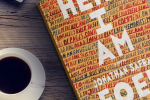Jacob is struggling with duality in his heart: Where, actually, is home? As he and Julia banter about the superiority of the house they currently share, it’s clear that this house is no longer his home. Even as he brushes his teeth at the bathroom sink, he is placeless. It’s simultaneously a more concrete and more vague rendering of the question of whether Israel is home.
One more example: As they unroll the Torah on the kitchen counter for Sam’s bar mitzvah, the family is stepping into the chain of tradition. Sam is chanting from “Vayeira,” the story of the binding of Isaac and the source for the title of our book (see Samantha’s bat mitzvah speech on page 101). Jacob has recently been ruminating on the parashah—section—from which he read on his own bar mitzvah: “Ki Tissa,” which includes a counting of the Israelites and the carving of the Ten Commandments. Later in the book, we’ll read that Max celebrates his bar mitzvah with “Vayishlah,” the parashah in which Jacob and Esau reconcile and take up residence in different parts of the land.
Each of these Torah readings grapples with an idea of home. For Sam, it is the notion of being present; for Jacob, it is about being seen; for Max, it is about being grounded. Don’t forget the tablets here—they are the touchstone for the portability of peoplehood. By bringing the tablets with them, anywhere the Israelites rest is home. That portability is underscored by the humorous image of the Torah leaving the house by Uber after the bar mitzvah service. The Torah’s power to create a sense of home shimmers when Sam chants, “Fully present as oneself.” In this text, the Blochs, and maybe even ourselves, have a place.
I don’t know if you celebrated becoming a bar or bat mitzvah, but if you did, do you feel like the parashah you read lodged itself in your identity and travels with you wherever you go? Funny enough, the Torah reading I did for my bat mitzvah is being chanted the very week I’m writing this. I do feel like it travels with me; I feel at home when I hear it, each time pulling me back to my sense of self, grounding me.
What does that for you? What makes you feel instinctively home, organically present? Is it a text, a place, a piece of music? Share your thoughts in the comments below!
Glossary of References
Have questions about any of the terms of references used in the book? Please let us know in the comments. Here is one reference from Section VI you may have wondered about.
Shofar (page 460)
A ram’s horn sounded on the High Holy Days. A ram caught in the thicket takes the place of Isaac in Abraham’s sacrifice, as described in parashah “Vayeira.”
Read On with CJP’s Jewish Learning and Engagement here. And order a hardcover copy of the book here, a Kindle version here and a paperback version (coming in June) here.
Never miss the best stories and events! Get JewishBoston This Week.
This post has been contributed by a third party. The opinions, facts and any media content are presented solely by the author, and JewishBoston assumes no responsibility for them. Want to add your voice to the conversation? Publish your own post here.
MORE














